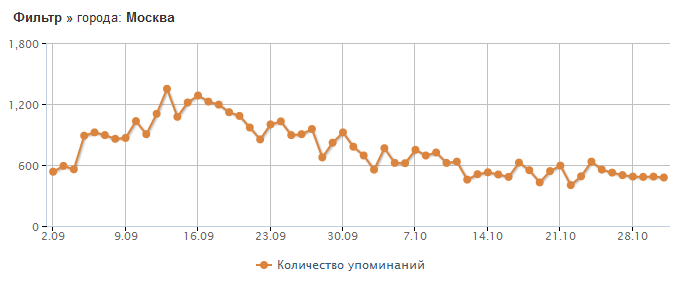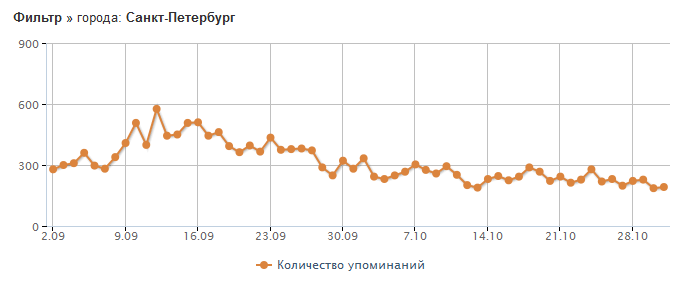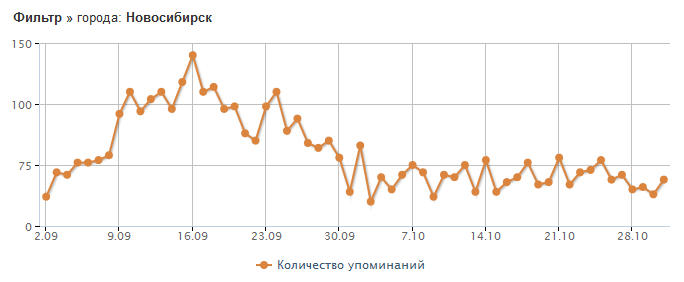Epidemic Spread: Social Media Analysis VS. Google Flu Query Analysis
Have you heard about Google Flu? Using analysis of search queries, Google builds a graph of the dynamics of "incidence" over time. We decided to check Google’s data by comparing it with the number of references to various colds in social media in Russia: when and where were outbreaks of epidemics recorded, who is often sick and what is complaining about? Answers under the cut.

Period: 09/01/13 - 10/31/13
Messages in social networks VKontakte, Twitter, Facebook, LiveJournal, etc. from Russia were analyzed using the Brand Analytics system .
Messages with words and phrases “coughing”, “sore throat”, “temperature rose”, “body aches” acted as indicators of colds.
In total, over 220 thousand such messages were recorded during this period.from Russia from 165 thousand authors .
Russian authors during the "normal" period write an average of 2,500 - 3,000 messages per day containing references to symptoms of colds. A sharp increase in the number of such messages is observed from September 7 to September 22 , which indicates a period of seasonal colds. Its peak falls on September 12 - 7.844 messages .

The sharp onset of autumn this year played a role, and, as expected, provoked an outbreak of morbidity.
The results of our study, firstly, correlate with Google Flu data: the period of the maximum number of requests falls on September 8-22 this year.
Secondly, the social media data is more correct in time - pay attention to the correlation between complaints about well-being in social networks and search queries:
To test our assumption (we strongly believe in it, but prognostication is not a fortuneteller and requires facts), we will follow the monitoring and promise to immediately share the results of the observations and inform in advance when it is better to protect yourself and your relatives from another flu epidemic and acute respiratory infections.

It is interesting to analyze the characteristics of the spread of diseases on the map of Russia. We studied the periods of seasonal diseases in different cities of our country and came to two main conclusions: a) the peak of diseases was observed in all cities, but of different strengths and b) everywhere the period of seasonal diseases coincides in time.
For example, the peak of diseases in Moscow is pronounced and falls on September 12, and the period of seasonal diseases completely coincides with the period of diseases in Russia.

In St. Petersburg, an increase in diseases has been seen since September 7, but in comparison with Moscow this increase is not so sharp and significant. Although the peak of diseases could also be observed in the 2nd week of September.

And finally, the city with the most pronounced period of seasonal colds is Novosibirsk. The graph shows the increase in patients from September 8 to 30, the peak of diseases (September 16), which has the greatest strength in comparison with Moscow and St. Petersburg.

This year, during a period of seasonal illness (September), social media authors often complained about the following aspects of their health:

Be healthy!

Period: 09/01/13 - 10/31/13
Messages in social networks VKontakte, Twitter, Facebook, LiveJournal, etc. from Russia were analyzed using the Brand Analytics system .
Messages with words and phrases “coughing”, “sore throat”, “temperature rose”, “body aches” acted as indicators of colds.
In total, over 220 thousand such messages were recorded during this period.from Russia from 165 thousand authors .
Russian authors during the "normal" period write an average of 2,500 - 3,000 messages per day containing references to symptoms of colds. A sharp increase in the number of such messages is observed from September 7 to September 22 , which indicates a period of seasonal colds. Its peak falls on September 12 - 7.844 messages .

The sharp onset of autumn this year played a role, and, as expected, provoked an outbreak of morbidity.
Comparison with Google Flu Results
The results of our study, firstly, correlate with Google Flu data: the period of the maximum number of requests falls on September 8-22 this year.
Secondly, the social media data is more correct in time - pay attention to the correlation between complaints about well-being in social networks and search queries:
- On September 12th, we record a peak in social media reports of painful symptoms,
- September 15th (that is, 3 days later) exhausted flu try to find treatment in Google.
To test our assumption (we strongly believe in it, but prognostication is not a fortuneteller and requires facts), we will follow the monitoring and promise to immediately share the results of the observations and inform in advance when it is better to protect yourself and your relatives from another flu epidemic and acute respiratory infections.

Geography
It is interesting to analyze the characteristics of the spread of diseases on the map of Russia. We studied the periods of seasonal diseases in different cities of our country and came to two main conclusions: a) the peak of diseases was observed in all cities, but of different strengths and b) everywhere the period of seasonal diseases coincides in time.
For example, the peak of diseases in Moscow is pronounced and falls on September 12, and the period of seasonal diseases completely coincides with the period of diseases in Russia.

In St. Petersburg, an increase in diseases has been seen since September 7, but in comparison with Moscow this increase is not so sharp and significant. Although the peak of diseases could also be observed in the 2nd week of September.

And finally, the city with the most pronounced period of seasonal colds is Novosibirsk. The graph shows the increase in patients from September 8 to 30, the peak of diseases (September 16), which has the greatest strength in comparison with Moscow and St. Petersburg.

The most common complaints
This year, during a period of seasonal illness (September), social media authors often complained about the following aspects of their health:
- Sore throat - 16.65% of the total number of messages
- Heat and fever - 8.52% of the total number of messages
- Headache - 2.43% of the total number of messages
- Cough - 2.38% of the total number of messages
- Body breaks - 1.55% of the total number of messages
- Chills - 1.14% of the total number of messages

Be healthy!
